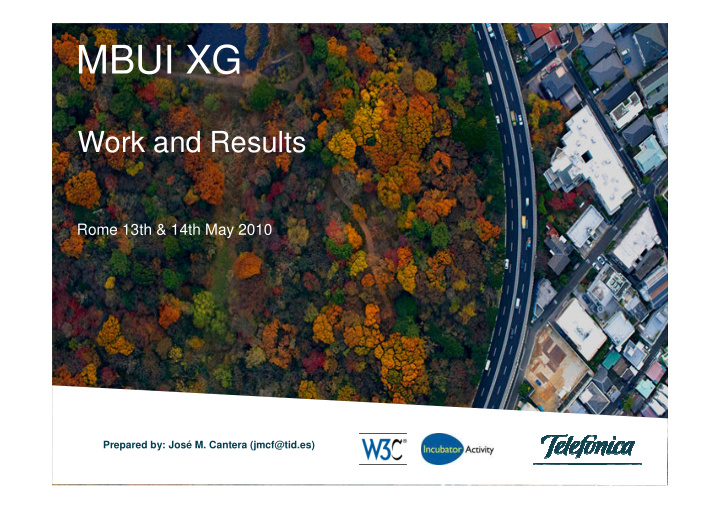



MBUI XG Work and Results Rome 13th & 14th May 2010 Prepared by: José M. Cantera (jmcf@tid.es)
MBUI – XG Overview � Main Founders (October 2008) � Chair: Dave Raggett � Mission • to evaluate research on model-based user interface design as a framework for authoring Web applications and with a view to proposing work on related standards Telefónica I+D
Cameleon � Reference Framework • for enabling the development of UIs supporting multiple targets, or multiple contexts of use in the field of context-aware computing � Principles • Model-Based approach • Coverage of both the design and run-time phases of a multi-target UI � Promotes a four-step forward engineering development path starting with domain concepts and task modeling. Telefónica I+D
Cameleon : Abstraction Levels Telefónica I+D
UIDL � A formal language used in HCI in order to describe a particular UI independently of any implementation technology � A UIDL is defined by : • Semantics : UML2, OWL2, … • Abstract Syntax : Independent of any representation language • Concrete Syntax/es : XML, RDF … • Stylistics : graphics … Telefónica I+D
Development Paths Telefónica I+D
Example Telefónica I+D
Cameleon : Context of Use � The Context of Use of an interactive system is a dynamic, structured information space that includes the following entities: • a model of the User , U • a model of the Platform , P • a model of the social and physical Environment , E, where the interaction is actually taking place. � A context of use is a triple composed by (U, P, E) Telefónica I+D
Context of Use and UIs � Multi-target (or multi-context) UI • supports multiple types of users, platforms and environments. � Adaptive UI • It is aware of the context of use and capable to (automatically) react to changes of this context in a continuous way Adaptable UI � Adaptable UI • can be tailored according to a set of predefined options. normally requires an explicit human intervention. � Plastic UI • multi-target UI that preserves usability across multiple targets. Telefónica I+D
Context Model (NEXOF-RA) Telefónica I+D
Platform Model : W3C’s DCO Telefónica I+D
GUMO and UserML � Proposed by Dominikus Heckmann (DFKI) in order to deal with the problem of representing generic user models. Example <statement> <mainpart> <subject>Peter</subject> <auxiliary>hasProperty</auxiliary> <predicate>walkingSpeed</predicate> <range>slow-medium-fast</range> <object>fast</object> </mainpart> <situation> <start>2010-04-09T19:20</start> <end>?</end> <durability>few minutes</durability> <location>airport.dutyfree</location> <position>X,Y,Z</position> </situation> <explanation> <source>sensor.repository</source> <creator>sensor.PW</creator> <method>Bayes</method> <evidence>LowLevelData</evidence> <confidence>0.8</confidence> </explanation> <privacy> <key>?</key> <owner>Peter</owner> <access>friends-only</access> <purpose>research</purpose> <retention>1 week</retention> </privacy> </statement> Telefónica I+D
Task Models : CTT Example Telefónica I+D
AUI Models : MARIA Telefónica I+D
AUI Models : UsiXML (Draft) Telefónica I+D
CUI Models : UsiXML (I) (incomplete draft) Telefónica I+D
CUI Models : UsiXML (II) (incomplete draft) Telefónica I+D
Benefits of MBUI Approaches � user-centered and UI-centered development process based on high level abstractions, � a declarative approach allowing developers to concentrate on what the application needs to do � Models facilitate the creation of multi target and context- sensitive user interfaces � Models can be used for automatic code generation thus enhancing productivity Telefónica I+D
Challenges for Deployment � Availability of authoring environments � Mainstream Web Development . • easy-to-be-learned � Standardization • What, When? � Incremental Adoption • From UIMLs to the whole Cameleon Framework � Flexibility • Modularity � Simplicity without losing powerfulness • Making everyday developer’s life easier � Interoperability • E.g. XForms Telefónica I+D
Suggested Standardization Work Items (I) � to start with the definition of the baseline meta-models and semantics for the different abstraction layers (Task & Concepts, AUI, CUI). • It is quite more difficult to get an agreement on a common syntax than on common meta-models and semantics • it will enable an incremental (and interoperable) adoption by software vendors that currently own XML-based languages for describing UIs. • Once Models are widely adopted a future action might consider the standardization of a common abstract or concrete syntax Telefónica I+D
Suggested Standardization Work Items (II) � Unified Reference Framework for MBUI • Based on the Cameleon RF � Task Meta-Model Recommendation • CTT and ANSI as starting points? � AUI Meta-Model Recommendation • UsiXML & MARIA convergence � CUI Meta-Model Recommendation • It can be difficult and time consuming � Context of Use Meta-Model Recommendation • Leveraging the DCO Telefónica I+D
MBUI – XGR Contributors Telefónica I+D
Recommend
More recommend